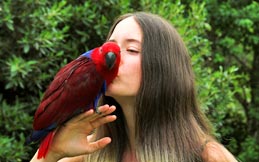
Parrots Care and Safety-Exposure to toxins
Never place a bird cage in a kitchen. Heated Teflon or non-stick pans emit poisonous gases that can kill a parrot. Also avoid exposure to lead paints, or any furniture or accessories (like a lead lamp chain) that contain this toxic material. Birds have very efficient respiratory systems so the fumes and poisons are absorbed very quickly.
You should also check if your house plants are safe. Even the beautiful poinsettia can be poisonous when ingested, and parrots love to peck and chew whatever they lay their eyes on!
Bleach, insecticides, and even spray disinfectants and air fresheners can hurt the parrots’ lungs. Don’t spray near the cage, and transfer your bird to another room if you plan to do any major cleaning.
You should also avoid smoking. It can damage human lungs, but its effects are more severe in birds.
Parrots Care and Safety-Trimming feathers and nails
Some owners prefer asking the veterinarian to perform this delicate procedure. But if you wish to do it yourself, wrap your pet in a towel and then slowly clip one feather at a time. It may try to wriggle in panic, but calm it by making very low, soft sounds. If you do this regularly it will eventually get used to the routine—it may even hold up its wings when it’s time for a trim.
As for nails, put the parrot on its perch, and then hold one toe. Snip off the sharpest point with a regular nail clipper. Don’t cut too close or you may cause bleeding—just in case, keep styptic pencil at hand.
Parrots Care and Safety-Proper interaction
Teach young children how to interact with pets. Many parents get angry at the bird for nipping or biting, when it was actually acting in mere self-defense. It may have been frightened by a toddler’s screaming, or angered after being poked with a finger or stick.
A little precaution goes a long way. Hang a cage out of reach of a toddler. Then, demonstrate to your child the proper way of approaching the parrot: soft voice, no sudden movements. Strictly prohibit shaking the cage or poking it with sharp objects.